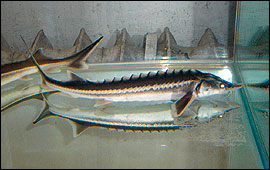Helping Danube sturgeons fight an upstream battle |
 |
A sterlet recently caught in Bulgaria
is believed to be a Ship Sturgeon,
a species that hasn't been seen in the river for more than 30
years. The
Action Plan for the Conservation of Sturgeons in the Danube River
Basin will help restore sturgeon populations |
Sturgeons were once abundant in the waters of the Danube; today
two of the six sturgeon species native to the basin are considered extinct
and the remaining four are on the brink of extinction. An Action Plan for
the Conservation of Sturgeons in the Danube River Basin is helping restore
sturgeon populations in the Danube and the Black Sea.
The plan, drafted by the International Association for Danube Research (IAD)
and WWF, was recently accepted under the Bern Convention by the Council
of Europe. According to the plan, restoring sturgeon populations requires
more than simply limiting exploitation. "We need to open the Iron Gates
to make migration possible," says Jürg Bloesch, former IAD president,
"and to make sure that upstream countries prepare good grounds for spawning
once sturgeons get there."
Sturgeon conservation needs basin-wide coordination. "The ICPDR", says Bloesch
"is in a position to play a significant role in driving these actions and
implementing measures." Healthy sturgeon populations could serve as indicators
of river health and contribute to reaching "good ecological status" of the
Danube River Basin as required by the EU Water Framework Directive. "If
sturgeons can migrate and spawn, completing their natural life-cycle," says
Bloesch, "that for me is a sign of good ecological status." For more information,
please visit: www.iad.gs
or www.wwf.at/stoer.